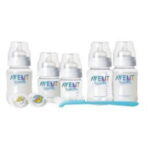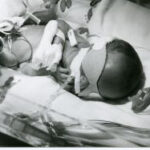Wash and Sterilize
Everything that comes into contact with the milk should be as clean as possible. Even your hands. So you should start by washing your hand thoroughly, getting the water as hot as you can manage. Next, the bottles need to be sterilized, as well as the containers, nipples, and pumps (if using one). Everything that is needed for feeding baby. Keep in mind that washing these items in the dishwasher is more effective than if you were washing them by hand. The high heat from the dishwasher kills more germs. But washing and sterilizing all the equipment that is needed will help to prevent baby from getting infections.
Storing Breast Milk
Most small babies only drink 2 – 3 oz. at one feeding. Even large babies usually only drink up to 6 oz. at a single feeding. So to prevent waste, you should store your milk in small amounts, such as 4 oz. or so per container.
It’s important that you do not pour warm milk on top of frozen milk. This could thaw it and cause bacteria to grow. You’ll need to chill the milk first before adding it to the already frozen container.
Be cautious that once your baby has fed from the bottle, to NOT reuse it after he’s done with it. Bacteria from your baby’s mouth and saliva will get into the milk and could grow and contaminate the milk in the bottle. You should NOT store and reuse this bottle, it should be discarded within an hour from the beginning time of feeding. Using milk after this hour, or a bottle that has been put back in the fridge after baby drank from it, could cause baby to get sick.
Refrigerated Breast Milk
Breast milk should be chilled after expressed or pumped (unless using it immediately). Whether it is stored for much later use in the freezer or for later in the day in the refrigerator.
Do not put the bottles in the door of the fridge, they can spoil faster, with the door opening and closing and the warm air hitting them repeatedly. You should store the bottles properly so it does not lose nutrients and won’t spoil. Refrigerated bottles should be used within 48 hours, but it is recommended to place the milk at the back of your freezer within 24 hours of being in the fridge.Use fresh milk as much as you can, and keep the frozen milk as backup.
Breast milk, after being stored, may change colors. Sometimes it can look yellowish, slightly brown, or maybe even blueish green. If the milk doesn’t taste sour, or smell bad, the it’s still good. As long as you use it within the time frame. (Fridge = 24-48 hours. Freezer = 3 months)
Remember to always label the container with the date you express the milk, and to use the oldest first.
Freezing Breast Milk
You can freeze breast milk to use for a later date. This will allow you to express more often, and have milk as backup. In case you are away from baby, and someone else has to feed, they can just thaw and warm a pre-made, rather than supplementing with formula. This way your baby does not skip his regular feeding.
It is recommended by doctors to use either glass containers or hard plastic containers to freeze breast milk in. Especially for newborns or sick babies. Although there are certain freezer bags designed for storing breast milk, using plastic bags could deprive your baby of anti-bacterial properties. These properties are needed to help baby fight illnesses. Using plastic bags can cause these cells to stick to the side of plastic bags. It’s best that if your baby is sick or premature, and is taking alot of feedings from pumped milk, you should use the hard plastic or glass containers for storing milk.
Frozen breast milk can be stored and used within 3 months, as long as the temperature is set to below 30°F. Or in a deep freeze, it can be stored up to 6 months at 0°F.
Remember to always label the container with the date you express the milk, and to use the oldest first.
Thawing and Warming
Frozen breast milk will thaw quicker than you would imagine.
To thaw and warm breast milk:
First, run the container, that the frozen milk is in, under lukewarm tap water, while constantly shaking it. Or you could place the container into a bowl of warm water. Pour the thawed milk into the bottle you’re going to use, and continue holding it in the warm water. You’ll want to shake the bottle to ensure an even temperature. Check a few drops on your wrist, you’ll want the milk to be body temperature. If it’s too hot it can scold baby and burn his mouth. If it’s too cold it could cause baby to have an upset stomach.
NEVER heat breast milk inside a microwave oven. The milk inside could get very hot without the bottle feeling hot, it warms unevenly and is dangerous to your baby. Also getting the bottle too hot could destroy the vitamins in the milk. But if you stick with these simple rules and tips, they will help to keep your breast milk fresh and your baby healthy.




